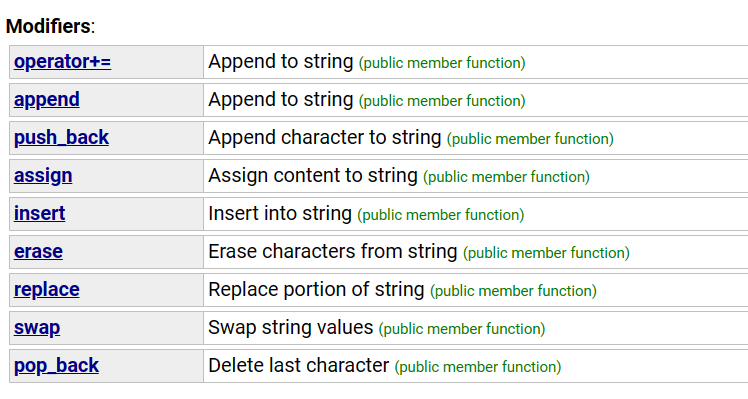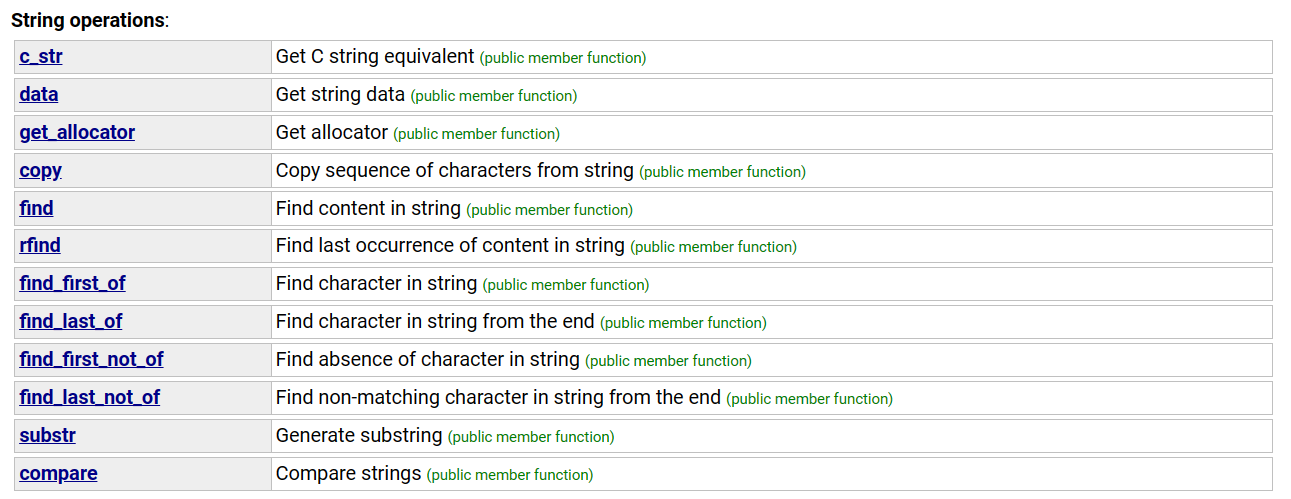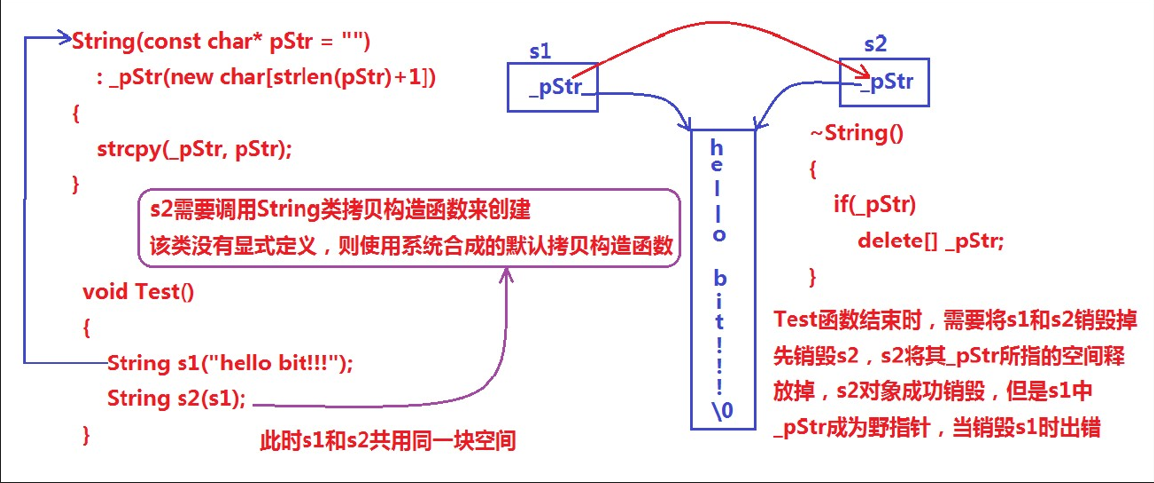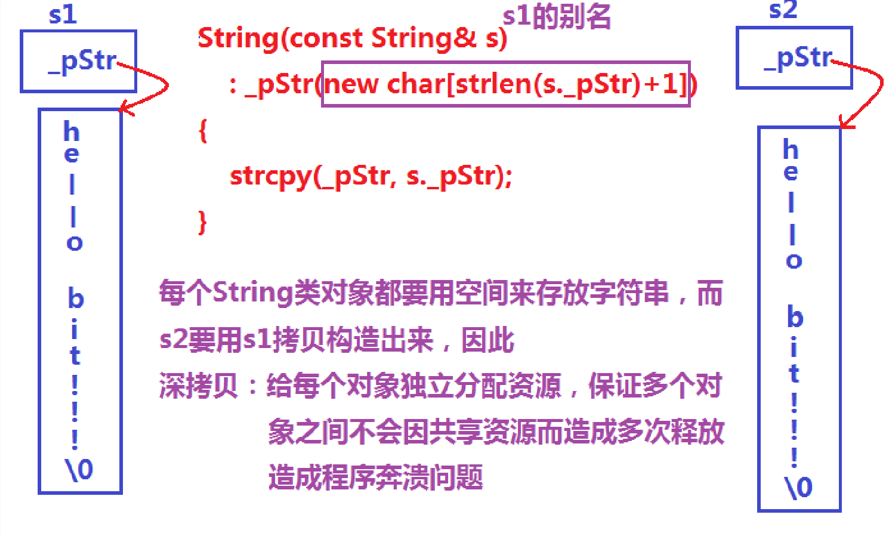目录
1.string类
2.string类的接口
2.1 成员函数
2.1.1 string构造函数
2.1.2 string赋值运算
2.1.3 string析构函数
2.2 string对象访问以及迭代器
2.2.1 string的遍历方式
2.2.2 迭代器的使用
2.2.3 const_迭代器的使用
2.2.4 at
2.2.5 back和front
2.3 string容量操作
2.3.1 size/length/capacity/clear/empty/resize
2.3.2 reserve
2.3.3 resize和reserve的区别
2.4 string修改操作
2.4.1 operator+=
2.4.2 push_back/pop_back
2.4.3 append
2.4.4 assign
2.4.5 insert / erase
2.4.6 replace
2.4.7 swap
2.5 string操作
2.5.1 c_str
2.5.2 data
2.5.3 copy
2.5.4 find/rfind
2.5.5 find_first/last_of和find_first/last_not_of
2.5.6 substr
2.5.7 compare
2.6 非成员函数接口
2.6.1 getline
3.string模拟实现
3.1经典string类问题
3.2 浅拷贝和深拷贝
3.3 string模拟实现代码(常用接口)
C语言中,字符串是以'\0'结尾的一些字符的集合,为了操作方便,C标准库中提供了一些str系列的库函数, 但是这些库函数与字符串是分离开的,不太符合OOP的思想,而且底层空间需要用户自己管理,稍不留神可能还会越界访问。
1.string类
1.string类是表示字符序列的类
2.标准的string类提供了对此类对象的支持,其接口类似于标准字符容器的接口,但添加了专门用于操作单字节字符字符串的设计特性。
3.string类是使用char(即作为它的字符类型,使用它的默认char_traits和分配器类型(关于模板的更多信息,请参阅basic_string)。
4.string类是basic_string模板类的一个实例,它使用char来实例化basic_string模板类,并用char_traits和allocator作为basic_string的默认参数(根于更多的模板信息请参basic_string)。
5.注意,这个类独立于所使用的编码来处理字节:如果用来处理多字节或变长字符(如UTF-8)的序列,这个类的所有成员(如长度或大小)以及它的迭代器,将仍然按照字节(而不是实际编码的字符)来操作。

总结:
1. string是表示字符串的字符串类
2. 该类的接口与常规容器的接口基本相同,再添加了一些专门用来操作string的常规操作。
3. string在底层实际是:basic_string模板类的别名,typedef basic_string string;
4. 不能操作多字节或者变长字符的序列。
在使用string类时,必须包含#include<string>头文件以及using namespace std
2.string类的接口
2.1 成员函数
2.1.1 string构造函数

| 函数名称 | 功能说明 |
| string() | 默认构造函数,创建一个空字符串。 |
| string(const char* str) | 使用C风格的字符串s构造一个string对象。 |
| string(const string& str) | 拷贝构造函数,用一个已有的string对象来构造新的对象。 |
| string(size_t n, char c) | 用字符c重复n次构造新的字符串。 |
| string(const char* str, size_t n) | 创建一个字符串对象,其内容是由 C 风格的字符串 str 的前 n 个字符给定的 |
| string(const string& str, size_t pos, size_t n = npos) | 创建一个字符串对象,其内容是字符串对象 str 中从位置 pos 开始的 n 个字符 |
| template <class InputIterator> string(InputIterator begin, InputIterator end) | 创建一个字符串对象,其内容是由迭代器对 [begin, end) 中的字符序列给定的 |
下面是这些接口的测试:
#include <iostream>#include <string>using namespace std;int main(){ // 1.string() string s1; // 构造空的string类对象s1 // 2.string(const char* str) string s2("Hello World\n"); // 用C格式字符串构造string类对象s2 string s3 = "Hello World"; // 3.string(const string& str) string s31(s3); // 拷贝构造s3 cout << s31 << endl; // Hello World // 4.string(size_t n, char c):用字符c重复n次构造新的字符串。 string s4(3, 'a'); cout << s4 << endl; // aaa // 5.string(const char* str, size_t n) :创建一个字符串对象,其内容是由 C 风格的字符串 str 的前 n 个字符给定的 string s5("Hello World", 5); // 取字符串前5个 cout << s5 << endl; // Hello // 6.string(const string& str, size_t pos, size_t n = npos) :创建一个字符串对象,其内容是字符串对象str中从位置pos开始的 n 个字符 string s6(s3, 6, 3); // 从s3的第6个字符开始取后三个字符 cout << s6 << endl; // Wor string s7(s3, 6, 13); // 取13个字符,超过了,就有多少取多少 cout << s7 << endl; // World string s8(s3, 1); // 取1后面的所有字符 cout << s8 << endl; // ello World for (size_t i = 0; i < s2.size(); i++) { s2[i]++; } cout << s2 << endl; // Ifmmp!Xpsme */ // 7.template <class InputIterator> string(InputIterator begin, InputIterator end):创建一个字符串对象,其内容是由迭代器对 [begin, end) 中的字符序列给定的 char arr[] = {'H', 'e', 'l', 'l', 'o'}; string str(begin(arr), end(arr)); // Hello cout << str << endl; return 0;}2.1.2 string赋值运算

| 函数名称 | 功能说明 |
| string& operator=(const string& str); | 将一个字符串对象 str 赋值给当前的字符串对象,返回当前字符串对象的引用。 |
| string& operator=(const char* s) | 将一个 C 风格的字符串 s 赋值给当前的字符串对象,返回当前字符串对象的引用。 |
| string& operator=(char c) | 将一个字符 c 赋值给当前的字符串对象,返回当前字符串对象的引用。 |
#include <iostream>#include <string>using namespace std;int main(){ // 1.string& operator=(const string& str) string str1 = "Hello"; string str2 = "World"; str1 = str2; // 将 str2 的值赋给 str1 cout << str1 << endl; // 输出:World // 2.string& operator=(const char* s) string str3 = "Hello"; str3 = "World"; // 将 C 风格字符串 "World" 赋给 str cout << str3 << endl; // 输出:World // string& operator=(char c) string str4 = "Hello"; str4 = 'W'; // 将字符 'W' 赋给 str cout << str4 << endl; // 输出:W return 0;}2.1.3 string析构函数
string 类的析构函数会自动被编译器生成,无需手动实现。当一个 string 类型的对象生命周期结束时,其析构函数会被自动调用,用于释放对象占用的内存空间。
string 类的析构函数没有任何参数,也没有返回值。它会自动释放对象占用的内存,包括对象所持有的动态内存和任何由 string 对象分配的缓冲区。
例如,当一个 string 类型的对象超出作用域、被 delete 运算符释放或者存储它的容器被销毁时,其析构函数会被自动调用。
2.2 string对象访问以及迭代器
2.2.1 string的遍历方式
| 函数名称 | 功能说明 |
| char& operator[](size_t pos) const char& operator[](size_t pos) const | 返回pos位置的字符,const string类对象调用 |
| iterator begin() const_iterator begin() const iterator end() const_iterator end() const | begin获取一个字符的迭代器 + end获取最后一个字符下一个位置的迭代器 |
| iterator rbegin() const_iterator rbegin() const iterator rend() const_iterator rend() const | begin获取一个字符的迭代器 + end获取最后一个字符下一个位置的迭代器 |
| 范围for | C++11支持更简洁的范围for的新遍历方式 |
// string的遍历// begin()+end() for+[] 范围for// 注意:string遍历时使用最多的还是for+下标 或者 范围for(C++11后才支持)// begin()+end()大多数使用在需要使用STL提供的算法操作string时,比如:采用reverse逆置stringvoid Teststring3(){ string s1("hello World"); const string s2("hello World2"); cout << s1 << " " << s2 << endl; // hello World hello World2 cout << s1[0] << " " << s2[0] << endl; // h H s1[0] = 'H'; cout << s1 << endl; // Hello World // s2[0] = 'h'; 代码编译失败,因为const类型对象不能修改}void Teststring4(){ string s("hello world"); // 3种遍历方式: // 需要注意的以下三种方式除了遍历string对象,还可以遍历是修改string中的字符, // 另外以下三种方式对于string而言,第一种使用最多 // 1. for+operator[] for (size_t i = 0; i < s.size(); ++i) cout << s[i] << " "; cout << endl; // 2.迭代器 string::iterator it = s.begin(); while (it != s.end()) { cout << *it << " "; ++it; } cout << endl; // string::reverse_iterator rit = s.rbegin(); // C++11之后,直接使用auto定义迭代器,让编译器推到迭代器的类型 auto rit = s.rbegin(); while (rit != s.rend()) { cout << *rit << " "; rit++; } cout << endl; // 3.范围for for (auto ch : s) cout << ch << " "; cout << endl;}2.2.2 迭代器的使用
int main(){ string s1("Hello World"); // 遍历和读写容器的数据 string::iterator it = s1.begin(); //H e l l o W o r l d while (it != s1.end()) { cout << *it << " "; it++; } cout << endl; // 反向迭代器 string s2("Hello World"); string::reverse_iterator rit = s2.rbegin(); while (rit != s2.rend()) { cout << *rit << " "; //d l r o W o l l e H rit++; } cout << endl; return 0;}2.2.3 const_迭代器的使用
int main(){ const string s("Hello World"); // 遍历和读容器的数据,不能写 // string::iterator it = s.begin(); //err s为const,迭代器也应该是const string::const_iterator it = s.begin(); while (it != s.end()) { //*it+=1;//err,const不能改变数据 cout << *it << " "; // H e l l o W o r l d it++; } cout << endl; // 反向const迭代器, string::const_reverse_iterator rit = s.rbegin(); // auto rit = s.rbegin(); //用auto类型代替string::const_reverse_iterator,auto编译器自动识别类型 while (rit != s.rend()) { cout << *rit << " "; //d l r o W o l l e H ++rit; //反向迭代器这里也是++,而不是-- } cout << endl; return 0;}2.2.4 at
在访问字符串时,如果指定的索引超出了字符串的范围,就会抛出异常
| char& at(size_t pos); | 返回一个引用,可以用于读取或修改字符串中指定位置的字符。 |
| const char& at(size_t pos) const; | 返回的是一个 const 引用,因此只能用于读取字符串中指定位置的字符,不能修改它。 |
#include <iostream>#include <string>using namespace std;int main(){ string str = "Hello World"; char first_char = str.at(0); char last_char = str.at(str.length() - 1); cout << "First character:" << first_char << endl; // First character:H cout << "Last character:" << last_char << endl; // Last character:d string str1 = "Hello World"; const char &ch = str.at(0); // ch = 'E'; //编译错误:尝试修改常量引用 const string str2 = "Hello World"; // str.at(0) = 'E'; //编译错误:尝试修改常量字符串 //string s1("Hello World"); //s1[100]; // 出错assert s1.at(100); // 超过索引范围,抛异常 return 0;}2.2.5 back和front
| char& back(); const char& back() const; | front函数返回一个对字符串第一个字符的引用,如果字符串为空,会导致未定义行为。 |
| char& front(); const char& front() const; | back函数返回一个对字符串最后一个字符的引用,如果字符串为空,也会导致未定义行为。 |
#include <iostream>#include <string>using namespace std;int main(){ string str = "Hello World"; char c1 = str.front(); char c2 = str.back(); cout << c1 << endl; //H cout << c2 << endl; //d return 0;}2.3 string容量操作
| 函数名称 | 功能说明 |
| size_t size() const | 返回字符串有效字符长度 |
| size_t length() const | 返回字符串有效字符长度 |
| size_t max_size() const | 返回字符串最大可能的大小,即 std::allocator_traits<allocator_type>::max_size() 的返回值。 |
| void resize(size_t n) void resize(size_t n, char c) | 将有效字符的个数该成n个,多出的空间用字符c填充 |
| size_t capacity() const | 返回空间总大小 |
| void reserve(size_t n = 0) | 为字符串预留空间 |
| void clear() | 清空有效字符 |
| bool empty() const | 检测字符串释放为空串,是返回true,否则返回false |
| void shrink_to_fit() | 请求字符串减小为其当前大小,可能会导致内存重新分配 |
2.3.1 size/length/capacity/clear/empty/resize
// size/length/capacity/clear/resize/emptyvoid Teststring(){ // 注意:string类对象支持直接用cin和cout进行输入和输出 string s("Hello,World!"); cout << s.size() << endl; // 12 cout << s.length() << endl; // 12 cout << s.capacity() << endl; // 15 显示15,其实容量是16,少一个\0 cout << s << endl; // 将s中的字符串清空,注意清空时只是将size清0,不改变底层空间的大小 s.clear(); cout << s.size() << endl; // 0 cout << s.capacity() << endl; // 15 // 将s中有效字符个数增加到10个,多出位置用'a'进行填充 // “aaaaaaaaaa” s.resize(10, 'a'); cout << s.size() << endl; // 10 cout << s.capacity() << endl; // 15 // 将s中有效字符个数增加到15个,多出位置用缺省值'\0'进行填充 // "aaaaaaaaaa\0\0\0\0\0" // 注意此时s中有效字符个数已经增加到15个 s.resize(15); cout << s.size() << endl; // 15 cout << s.capacity() << endl; // 15 cout << s << endl; // aaaaaaaaaa // 将s中有效字符个数缩小到5个 s.resize(5); cout << s.size() << endl; // 5 cout << s.capacity() << endl; // 15 size缩小,不会改变capacity cout << s << endl; // aaaaa cout << s.max_size() << endl; // 9223372036854775807 cout << s.empty() << endl; // 0 s.clear(); cout << s.empty() << endl; // 1}int main(){ Teststring(); return 0;}2.3.2 reserve
测试reserve是否会改变string中有效元素个数
void Teststring(){ string s; // 测试reserve是否会改变string中有效元素个数 s.reserve(100); cout << s.size() << endl; //0 cout << s.capacity() << endl; //100 // 测试reserve参数小于string的底层空间大小时,是否会将空间缩小 s.reserve(50); cout << s.size() << endl; //0 cout << s.capacity() << endl; //50 // reserve无法缩容到 s="Hello World"; s.reserve(1); cout<<s.size()<<endl; //11 cout<<s.capacity()<<endl; //15 s.reserve(17); cout<<s.capacity()<<endl; //30 reserve默认扩容2倍,不同编译器下结果不同 s.reserve(1); cout<<s.capacity()<<endl; //15 reserve缩容不会缩小到字符串有效长度的空间还小,只能缩容之前reserve过的空闲空间}reserve不会改变string中有效元素个数
reserve参数小于string空间时,会使空间变小,但不会小于有效元素个数大小
reserve默认扩容2倍,不同编译器下结果不同
利用reserve提高插入数据的效率,避免增容的开销
测试代码:利用reserve提高插入数据的效率,避免增容带来的开销
// 利用reserve提高插入数据的效率,避免增容带来的开销void TestPushBack(){ string s; size_t sz = s.capacity(); cout << "making s grow:\n"; for (int i = 0; i < 100; ++i) { s.push_back('c'); if (sz != s.capacity()) { sz = s.capacity(); cout << "capacity changed: " << sz << '\n'; } }}// 构建vector时,如果提前已经知道string中大概要放多少个元素,可以提前将string中空间设置好void TestPushBackReserve(){ string s; s.reserve(100); size_t sz = s.capacity(); cout << "making s grow:\n"; for (int i = 0; i < 100; ++i) { s.push_back('c'); if (sz != s.capacity()) { sz = s.capacity(); cout << "capacity changed: " << sz << '\n'; } }}
2.3.3 resize和reserve的区别
int main(){ string s1("Hello World"); // 扩容 s1.reserve(100); cout << s1.size() << endl; // 11 cout << s1.capacity() << endl; // 100 string s2("Hello World"); // 扩容+初始化 s2.resize(100); // 默认填充0 cout << s2.size() << endl; // 100 s2.resize(100, 'x'); // 填充x cout << s2.size() << endl; // 100 cout << s2.capacity() << endl; // 100 // 比size小,就不是扩容,就是删除,size会变,但capacity不变 // 缩容不支持原地缩容 s2.resize(5); cout << s2.size() << endl; //5 cout << s2.capacity() << endl; //100 return 0;}string的resize会改变其大小并且可能会改变其内容,而reserve仅仅是为string预留一定的内存空间,不改变其大小和内容。
注意:
1. size()与length()方法底层实现原理完全相同,引入size()的原因是为了与其他容器的接口保持一 致,一般情况下基本都是用size()。
2. clear()只是将string中有效字符清空,不改变底层空间大小。
3. resize(size_t n) 与 resize(size_t n, char c)都是将字符串中有效字符个数改变到n个,不同的是当字符个数增多时:resize(n)用0来填充多出的元素空间,resize(size_t n, char c)用字符c来填充多出的 元素空间。注意:resize在改变元素个数时,如果是将元素个数增多,可能会改变底层容量的大 小,如果是将元素个数减少,底层空间总大小不变。
4. reserve(size_t res_arg=0):为string预留空间,不改变有效元素个数,当reserve的参数小于string的底层空间总大小时,reserver不会改变容量大小。
2.4 string修改操作

2.4.1 operator+=

int main(){ string str = "Hello"; char c = ' '; //string& operator+=(char c); str += c; //string& operator+=(const char* s); str += 'w'; //string& operator++(const string& str); str += "orld"; cout << str << endl; return 0;}2.4.2 push_back/pop_back


int main(){ string str = "Hello"; str.push_back('a'); cout << str << endl; //Helloa str.pop_back(); cout << str << endl; //Hello return 0; }2.4.3 append

#include <iostream>#include <string>#include <vector>using namespace std;int main(){ // 1.string& append(const string& str) string str = "hello"; string appendstr = " world!"; str.append(appendstr); cout << str << endl; // hello world! // 2.string& append(const string& str, size_t subpos, size_t sublen) // 将给定字符串str的子串(从索引subpos开始,长度为sublen)添加到当前字符串的末尾。 string str1 = "hello"; string appendStr1 = " world!"; str1.append(appendStr1, 0, 5); // 添加另一个字符串的子串,即" worl" cout << str1 << endl; // 输出:hello worl // 3.string& append(const char* s) string str2 = "hello"; const char *cstr = " world!"; str2.append(cstr); // 添加完整的字符数组,即" world!" cout << str2 << endl; // 输出:hello world! // 4.string& append(const char* s, size_t n) // 将给定的字符数组s的前n个字符添加到当前字符串的末尾。 string str3 = "hello"; const char *cstr3 = " world!"; str3.append(cstr3, 7); // 添加" world!"的前7个字符,即" world" cout << str3 << endl; // 输出:hello world // 5. string& append(size_t n, char c) // 将字符c重复n次添加到当前字符串的末尾。 string str4 = "hello"; str4.append(3, '!'); // 添加3个感叹号 cout << str4 << endl; // 输出:hello!!! // 6. // template<class InputIterator> // void append(InputIterator first, InputIterator last); // 作用是将从first到last区间中的所有元素添加到当前std::string对象的末尾。 vector<char> vec{'H', 'e', 'l', 'l', 'o', ',', ' ', 'W', 'o', 'r', 'l', 'd', '!'}; string str5; str5.append(vec.begin(), vec.end()); cout << str5 << endl; // hello,world! return 0;}2.4.4 assign
可以用于将一个字符串替换成新的字符串

#include <iostream>#include <string>#include <vector>using namespace std;int main(){ // 1.string& assign(const string& str) string s1 = "Hello"; string s2; s2.assign(s1); cout << s2 << endl; // Hello // 2.string& assign(const std::string& str, size_t subpos, size_t sublen) // 将字符串对象设置为另一个字符串对象str的子串,子串从subpos开始,长度为sublen。 string s3 = "Hello World!"; string s4; s4.assign(s3, 6, 5); // cout << s4 << endl; // World // 3.string& assign(const char*s) string s5; const char *cstr = "Hello World!"; s5.assign(cstr); // cout << s5 << endl; // Hello World! // 4.string& assign(const char* s, size_t n) string s6; const char *cstr1 = "Hello World!"; s6.assign(cstr1, 5); cout << s6 << endl; // Hello // 5.string& assign(size_t n, char c) string s7; s7.assign(5, 'a'); cout << s7 << endl; // aaaaa // 6.template <class InputIterator> // string &assign(InputIterator first, InputIterator last); // 将字符串对象设置为迭代器[first, last)所指范围内的字符序列的副本。 string s8; vector<char> vec = {'H', 'e', 'l', 'l', 'o'}; s8.assign(vec.begin(), vec.end()); cout << s8 << endl; // Hello return 0;}2.4.5 insert / erase


int main(){ string s1("World"); s1.insert(0, "hello"); cout << s1 << endl; // // s1.insert(5, " "); //在s1第五个位置插入空格 // s1.insert(5,' '); //err // s1.insert(5, 1, ' '); // 在s1第五个位置插入1个字符 s1.insert(s1.begin() + 5, ' '); cout << s1 << endl; // insert/erase不推荐经常使用,能少用就少用 // 因为他们可能都存在挪动数据效率低下 string s2("Hello World"); // s2.erase(5, 1); //删除第五个位置1个字符 s2.erase(s2.begin() + 5); // 删除第五个位置后面的字符 cout << s2 << endl; s2.erase(5, 30); // 超过字符串长度,删除所有的 s2.erase(5); // 删除所有的用这种方式 cout << s2 << endl; return 0;}2.4.6 replace
替换字符串
int main(){ string s1("Hello World"); s1.replace(5, 1, "%%d"); cout << s1 << endl; //Hello%%dWorld string s2("Hello World i love you"); size_t num = 0; for (auto ch : s2) { if (ch == ' ') num++; } // 提前开空间,避免replace时扩容 s2.reserve(s2.size() + 2 * num); size_t pos = s2.find(' '); while (pos != string::npos) { s2.replace(pos, 1, "%20"); pos = s2.find(' ', pos + 3); // pos+3的位置是越过了%20 } cout << s2 << endl; //Hello%20World%20i%20love%20you return 0;}2.4.7 swap

为什么C++库里面已经有swap函数了,为什么string里还有swap
库里的库函数深拷贝,效率低
int main(){ string newStr = "Hello,World"; string s1 = newStr; cout << newStr << endl; // Hello,World string s2("xxxxx"); s1.swap(s2); cout << s1 << endl; // xxxxx cout << s2 << endl; // Hello,World swap(s1, s2); cout << s1 << endl; // Hello,World cout << s2 << endl; // xxxxx return 0;}2.5 string操作

2.5.1 c_str
返回C格式字符串
int main(){ string s1("Hello World"); cout << s1 << endl; // c_str 是指针 cout << s1.c_str() << endl; cout << (void *)s1.c_str() << endl; s1 += '\0'; s1 += '\0'; s1 += "xxxxx"; cout << s1 << endl; // Hello Worldxxxxx cout << s1.c_str() << endl; // Hello World C语言方式打印,遇到\0结束 // c_str 用于C语言方式字符串 string filename("test.cpp"); FILE *fout = fopen(filename.c_str(), "read"); char ch = fgetc(fout); while (ch != EOF) { cout << ch; ch = fgetc(fout); } fclose(fout); return 0;}2.5.2 data
返回指向string对象中存储的字符数组的指针,即返回一个C风格的字符串指针。
int main(){ string str = "Hello, world!"; const char *cstr = str.data(); cout << "The string is: " << str << endl; //The string is: Hello, world cout << "The C-style string is: " << cstr << endl; //The C-style string is: Hello, world! // 修改字符串 string new_str(cstr); new_str[0] = 'h'; cout << "The modified C-style string is: " << new_str.c_str() << endl; //The modified C-style string is: hello, world! cout << "The modified string is: " << new_str << endl; //The modified string is: hello, world! return 0;}2.5.3 copy
int main(){ // size_t copy (char* s, size_t len, size_t pos = 0) const; // 其中,c是一个指向目标字符数组的指针,len是要复制的字符数,pos是开始复制的位置,默认值为 0。 string str = "Hello World!"; char buf[6]; size_t n = str.copy(buf, 5, 6); buf[n] = '\0'; cout << buf << endl; // World return 0;}2.5.4 find/rfind
find 函数返回子字符串第一次出现的位置,如果子字符串未找到,则返回 npos。
rfind 方法返回子字符串最后一次出现的位置,如果子字符串未找到,则返回npos


npos是string里面的一个静态成员变量
static const size_t npos = -1;
int main(){ string str1 = "Hello World,Hello World"; string str2 = "Wor"; cout << str1.find(str2) << endl; // 6 cout << str1.rfind(str2) << endl; // 18 cout << str1.find("Wor") << endl; // 6 cout << str1.rfind("Wor") << endl; // 18 const char *substr = "Wor"; cout << str1.find(substr) << endl; // 6 cout << str1.rfind(substr) << endl; // 18 cout << str1.find('d') << endl; // 10 cout << str1.rfind('d') << endl; // 22 return 0;}2.5.5 find_first/last_of和find_first/last_not_of
用于在字符串中查找第一次/最后一次出现指定字符集合中任何一个字符的位置。

用于再字符串中查找第一次/最后一次不是出现指定字符集合中任何一个字符的位置
int main(){ string str = "Hello World,Hello World"; cout << str.find_first_of("aeiou") << endl; // 查找"aeiou"第一次出现的位置,Hello World e为1 cout << str.find_last_of("aeiou") << endl; // 最后出现"aeiou"的位置是19 cout << str.find_first_not_of("aeiou") << endl; // 查找第一次不是"aeiou"出现的位置 为0 H一开始就不是 cout << str.find_last_not_of("aeiou") << endl; // 查找最后一次不是的位置 22 为d return 0;}2.5.6 substr

用于返回字符串中指定位置和长度的子字符串。
int main(){ string str = "Hello, world!"; string substr1 = str.substr(7, 5); // 从位置7开始提取长度为5的子字符串,得到"world" string substr2 = str.substr(0, 5); // 从位置0开始提取长度为5的子字符串,得到"Hello" string substr3 = str.substr(7); // 从位置7开始提取到字符串末尾的子字符串,得到"world!" cout << substr1 << endl; // 输出"world" cout << substr2 << endl; // 输出"Hello" cout << substr3 << endl; // 输出"world!" return 0;}2.5.7 compare
用于比较两个字符串的成员函数,它返回一个整数值,表示两个字符串的大小关系
如果当前字符串对象小于str,则返回一个负数(通常是 -1)。如果当前字符串对象等于 str,则返回 0。如果当前字符串对象大于 str,则返回一个正数(通常是 1)。 int main() { string str1 = "apple"; string str2 = "banana"; string str3 = "apple"; int result1 = str1.compare(str2); int result2 = str1.compare(str3); cout << "str1 vs str2: " << result1 << endl; // 输出-1 cout << "str1 vs str3: " << result2 << endl; // 输出0 return 0;}2.6 非成员函数接口


2.6.1 getline
istream& getline (istream& is, string& str, char delim);此函数将输入流对象 is 中的文本读取到 str 字符串中,直到遇到分隔符 delim 或文件结尾。如果 delim 参数被省略,则默认使用换行符 \n 作为分隔符。
int main(){ string name; cout << "Please enter your name: "; getline(cin, name); cout << "Hello, " << name << "!" << endl; return 0;}3.string模拟实现
3.1经典string类问题
上面已经对string类进行了简单的介绍,大家只要能够正常使用即可。在面试中,面试官总喜欢让学生自己 来模拟实现string类,最主要是实现string类的构造、拷贝构造、赋值运算符重载以及析构函数。大家看下以 下string类的实现是否有问题?
// 为了和标准库区分,此处使用Stringclass String{public: /*String() :_str(new char[1]) {*_str = '\0';} */ // String(const char* str = "\0") 错误示范 // String(const char* str = nullptr) 错误示范 String(const char *str = "") { // 构造String类对象时,如果传递nullptr指针,可以认为程序非 if (nullptr == str) { assert(false); return; } _str = new char[strlen(str) + 1]; strcpy(_str, str); } ~String() { if (_str) { delete[] _str; _str = nullptr; } }private: char *_str;};// 测试void TestString(){ String s1("hello bit!!!"); String s2(s1);}
说明:上述String类没有显式定义其拷贝构造函数与赋值运算符重载,此时编译器会合成默认的,当用s1构 造s2时,编译器会调用默认的拷贝构造。最终导致的问题是,s1、s2共用同一块内存空间,在释放时同一块 空间被释放多次而引起程序崩溃,这种拷贝方式,称为浅拷贝。
3.2 浅拷贝和深拷贝
浅拷贝:也称位拷贝,编译器只是将对象中的值拷贝过来。如果对象中管理资源,最后就会导致多个对象共 享同一份资源,当一个对象销毁时就会将该资源释放掉,而此时另一些对象不知道该资源已经被释放,以为 还有效,所以当继续对资源进项操作时,就会发生发生了访问违规。
就像一个家庭中有两个孩子,但父母只买了一份玩具,两个孩子愿意一块玩,则万事大吉,万一不想分享就 你争我夺,玩具损坏。
可以采用深拷贝解决浅拷贝问题,即:每个对象都有一份独立的资源,不要和其他对象共享。父母给每个孩 子都买一份玩具,各自玩各自的就不会有问题了。
如果一个类中涉及到资源的管理,其拷贝构造函数、赋值运算符重载以及析构函数必须要显式给出。一般情况都是按照深拷贝方式提供。

3.3 string模拟实现代码(常用接口)
#pragma once#include <iostream>#include <string.h>#include <assert.h>using namespace std;namespace phw{class string{private:friend ostream &operator<<(ostream &out, const phw::string &s);friend istream &operator>>(istream &in, phw::string &s);public:// 带参构造函数// string(const char* str = nullptr) //不可以 给空指针,strlen会报错// string(const char* str = '\0') //\0 char转换成指针,也是空指针// string(const char* str = "\0") //可以,给常量字符串,strlen不会报错string(const char *str = "") // 空字符串默认是\0: _size(strlen(str)){_capacity = _size == 0 ? 3 : _size; // 最少给3个字节空间_str = new char[_capacity + 1];// new _capacity+1 capacity是字符串容量,存放的有效字符大小,不是空间,空间还有一个\0strcpy(_str, str);}// 拷贝构造string(const string &s): _size(s._size), _capacity(s._capacity){//_str自己开空间_str = new char[s._capacity + 1];strcpy(_str, s._str);}// 赋值是对已经定义的对象进行赋值// 有一种情况是,原对象的空间远大于要赋值的对象,那么就会出现空间浪费// 所以首先应该delete掉原空间的内存,在进行赋值string &operator=(const string &s){if (this != &s){// delete[]_str; //赋值提前把旧空间释放,防止浪费空间//_str = new char[s._capacity + 1];// strcpy(_str, s._str);//_size = s._size;//_capacity = s._capacity;// 下面的写法更加安全char *tmp = new char[s._capacity + 1];strcpy(tmp, s._str);delete[] _str;_str = tmp;_size = s._size;_capacity = s._capacity;}return *this;}// 迭代器相关typedef char *iterator;typedef const char *const_iterator;iterator begin(){return _str;}const_iterator begin() const{return _str;}iterator end(){return _str + _size;}const_iterator end() const{return _str + _size;}// 获取字符串const char *c_str(){return _str;}//[]通过下标来访问字符char &operator[](size_t pos){return _str[pos];}// 访问const类型的数组const char &operator[](size_t pos) const{return _str[pos];}size_t size() const{return _size;}size_t capacity() const{return _capacity;}~string(){delete[] _str;_size = 0;_capacity = 0;}void Print(const string &s){for (size_t i = 0; i < s.size(); i++){cout << s._str[i] << " ";}cout << endl;// 这里不支持范围for了,为什么? 因为这里s是const对象,只能调用const迭代器string::const_iterator it = s.begin();while (it != s.end()){//(*it)++; //err. const迭代器指向的内容不能修改it++;}// 这里没有定义const迭代器,就会报错,范围for的底层就是迭代器for (auto ch : s){cout << ch << " ";}cout << endl;}// 不修改成员变量数据的函数,最好加上constbool operator==(const string &s) const{return strcmp(_str, s._str) == 0;}bool operator!=(const string &s) const{return !(_str == s._str);}bool operator>(const string &s) const{return strcmp(_str, s._str) > 0;}bool operator>=(const string &s) const{return *this > s || *this == s;}bool operator<(const string &s) const{return !(*this >= s);}bool operator<=(const string &s) const{return !(*this > s);}// 开空间void reserve(size_t n){if (n > _capacity){char *tmp = new char[n + 1];strcpy(tmp, _str);delete[] _str;_str = tmp;_capacity = n;}}// 扩容+初始化void resize(size_t n, char ch = '\0'){// 当n小于_size的时候,不需要扩容,也不需要缩容// n大于_size的时候,并且当n>capacit的时候需要扩容,就直接调用reserveif (n < _size){// 保留前n个_size = n;_str[_size] = '\0';}else{if (n > _capacity){reserve(n);}// 不大于则不需要设置_capacity// 从_size开始 到需要扩容n开始,初始化\0size_t i = _size;while (i < n){_str[i] = ch;i++;}_size = n;// 将最后的下一个位置也设置为\0_str[_size] = '\0';}}void push_back(char ch){if (_size + 1 > _capacity){reserve(_capacity * 2);}_str[_size] = ch;_size++;_str[_size] = '\0';}// 尾插字符串void append(const char *str){size_t len = strlen(str);if (_size + len > _capacity){reserve(_size + len);}strcpy(_str + _size, str); // 从_str+_size开始拷贝// strcat(_str, str); //strcat会找\0,效率低下_size += len;_str[_size] = '\0';}string &operator+=(const char *str){append(str);return *this;}string &operator+=(const char ch){push_back(ch);return *this;}string &insert(size_t pos, char ch){assert(pos <= _size);if (_size + 1 > _capacity){reserve(_capacity * 2);}int end = _size;// 这里的pos需要改成int pos是无符号类型,和end对比,end会转换成无符号类型// 当pos的位置是0时,end为无符号类型将永远不会小于0,程序无限循环。// 需要将pos转换成int,那么end就为int类型while (end >= (int)pos){_str[end + 1] = _str[end];end--;}_str[pos] = ch;_size++;return *this;}string &insert(size_t pos, const char *str){assert(pos <= _size);int len = strlen(str);int end = _size + len;if (_size + len > _capacity){reserve(_size + len);}while (end > pos + len - 1){_str[end] = _str[end - len];end--;}strncpy(_str + pos, str, len);_size += len;return *this;}string &erase(size_t pos, size_t len = npos){// 如果要删的个数远超于剩余的个数,就是pos位置后面全部删除,直接在pos位置后面置\0即可// len == npos必须加上,npos是最大值if (len == npos || pos + len >= _size){_str[pos] = '\0';_size = pos;}else{strcpy(_str + pos, _str + pos + len); // 删除pos+len位置的字符串_size -= len;}return *this;}void swap(string &s){std::swap(_str, s._str);std::swap(_size, s._size);std::swap(_capacity, s._capacity);}size_t find(char ch, size_t pos = 0){assert(pos < _size);for (size_t i = 0; i < _size; i++){if (_str[i] == ch){return i;}}}// 返回子串str在string中第一次出现的位置size_t find(const char *str, size_t pos = 0){assert(pos < _size);// p是str出现在_str+pos出现的位置,返回的是指针char *p = strstr(_str + pos, str);if (p == nullptr){return npos;}else{return p - _str;}}void clear(){_str[0] = '\0';_size = 0;}private:char *_str;size_t _size;size_t _capacity; // 真实容量要比_size多1,多一个\0// 静态成员变量不能给缺省值,但是加上const就可以了,只针对整型static const size_t npos = -1;// static const size_t N = 10;// int _a[N];};ostream &operator<<(ostream &out, const phw::string &s){for (size_t i = 0; i < s.size(); i++){out << s[i];}return out;}istream &operator>>(istream &in, phw::string &s){s.clear(); // 一开始就清理缓冲区char ch = in.get();char buff[128];size_t i = 0;while (ch != ' ' && ch != '\n'){// s += ch; //字符串太长可能会容量不够,用reserve如何控制扩容? 扩容会频繁调用buff[i++] = ch;if (i == 127){buff[127] = '\0';s += buff;i = 0;}ch = in.get();}if (i != 0){buff[i] = '\0';s += buff;}// getline实现/*while (ch != '\n'){s += ch;ch = in.get();}*/return in;}}#include "string.h"void test1(){phw::string s1;phw::string s2("Hello World\n");cout << s1.c_str() << endl;cout << s2.c_str() << endl; // Hello World}void test2(){phw::string s1;phw::string s2("hello world");phw::string s3(s2);// 编译器默认的构造函数,浅拷贝,s2和s3的str指向了同一个空间,析构会出问题cout << s2.c_str() << endl; // hello worldcout << s3.c_str() << endl; // hello world// 不自己写拷贝构造结果是s2变,s3跟着变,因为s2和s3指向同一个空间// s2[0]++;// cout << s2.c_str() << endl; //iello world// cout << s3.c_str() << endl; //iello worlds2[0]++;cout << s2.c_str() << endl; // iello worldcout << s3.c_str() << endl; // hello worlds1 = s3;// 自己不写还是会报错,因为还是浅拷贝cout << s1.c_str() << endl; // hello worldcout << s3.c_str() << endl; // hello worlds1 = s1;}void test3(){phw::string s1("Hello World");for (size_t i = 0; i < s1.size(); i++){s1[i]++;}for (size_t i = 0; i < s1.size(); i++){cout << s1[i] << " "; // I f m m p ! X p s m e}cout << endl;s1.Print(s1); // I f m m p ! X p s m ephw::string::iterator it = s1.begin();while (it != s1.end()){(*it)--;it++;}it = s1.begin();while (it != s1.end()){cout << *it << " "; // H e l l o W o r l dit++;}cout << endl;for (auto ch : s1) // 底层就是将*it替换成ch{cout << ch << " "; // H e l l o W o r l d}cout << endl;}// string比较大小void test4(){phw::string s1("hello world");phw::string s2("hello world");phw::string s3("xx");cout << (s1 < s2) << endl;// 0cout << (s1 == s2) << endl; // 1cout << (s1 > s2) << endl;// 0}void test5(){phw::string s1("Hello World");s1.push_back('a');s1.append("xxxxxxxxxx");s1 += 'W';s1 += "!!!!!!!!!!!!";cout << s1.c_str() << endl; // Hello WorldaxxxxxxxxxxW!!!!!!!!!!!!phw::string s2 = "Hello World";s2.insert(5, 'X');cout << s2.c_str() << endl; // HelloX Worlds2.insert(0, 'A');cout << s2.c_str() << endl; // AHelloX Worlds2.insert(0, "PHW");cout << s2.c_str() << endl; // PHWAHelloX Worlds2.erase(0, 3);cout << s2.c_str() << endl; // AHelloX Worlds2.erase(5, 10);cout << s2.c_str() << endl; // AHell}// 流插入重载必须实现成友元函数? 不对void test6(){std::string s1("0123456789");phw::string s2("0123456789");s1 += '\0';s2 += '\0';s1 += "xxxx";s2 += "xxxx";cout << s1 << endl;// 0123456789xxxxcout << s2.c_str() << endl; // 0123456789 遇到\0终止cout << s2 << endl;// 0123456789xxxxphw::string s3;cin >> s3;cout << s3 << endl;}void test7(){phw::string s1;std::string s2;cout << sizeof(s1) << endl; // 12cout << sizeof(s2) << endl; // 28s1 = "hello";s2 = "hello";cout << sizeof(s1) << endl; // 12cout << sizeof(s2) << endl; // 28// g++ 中x86 4字节 x64 8字节// g++中存的是指针}void test8(){string s1 = "Hello World";int pos = s1.find("Wor", 3);s1[pos] = 'A'; // Hello Aorldcout << s1;}int main(){// test8();return 0;}